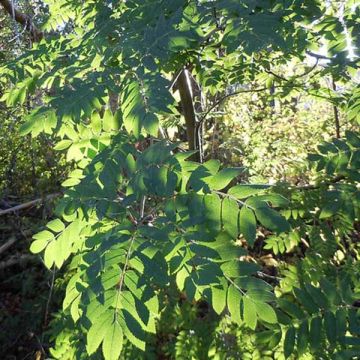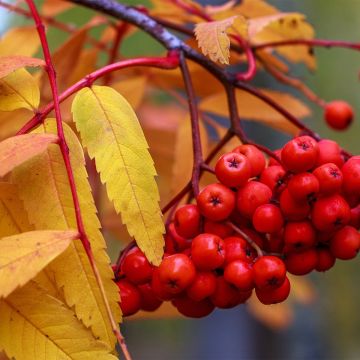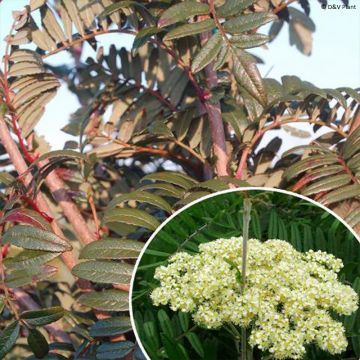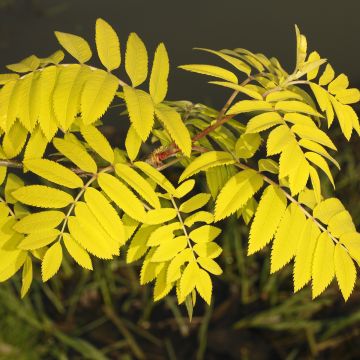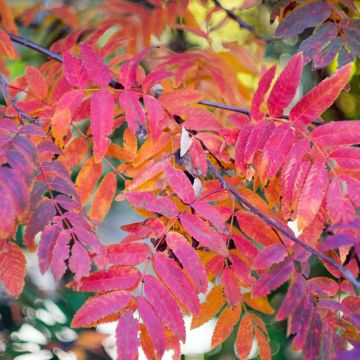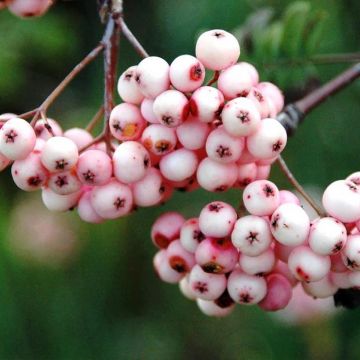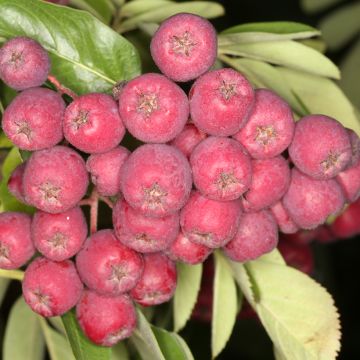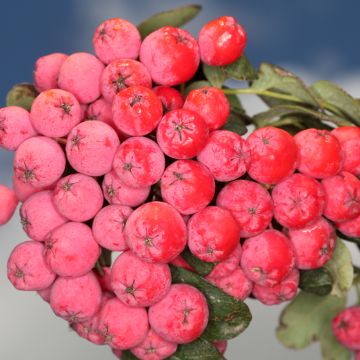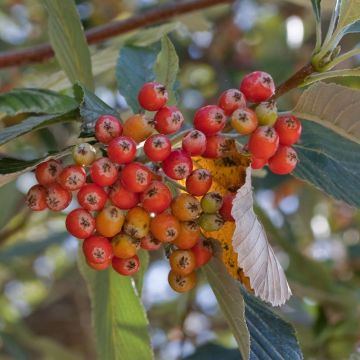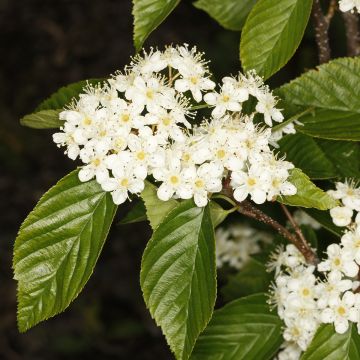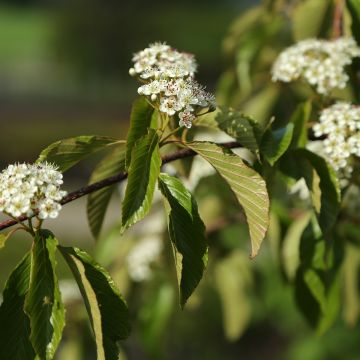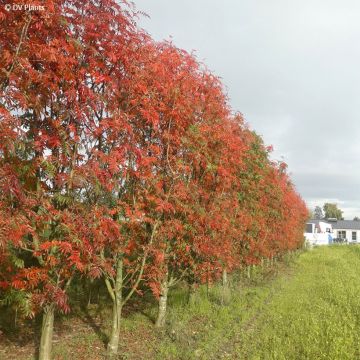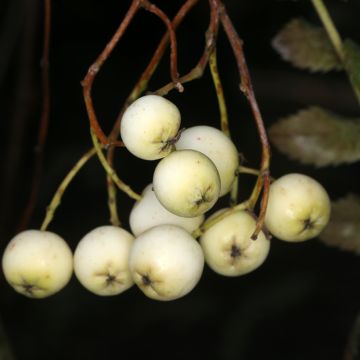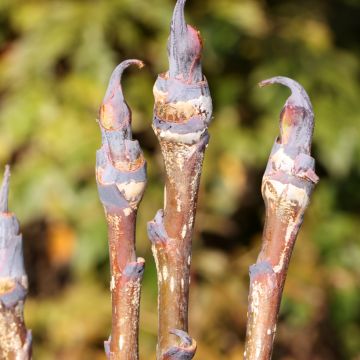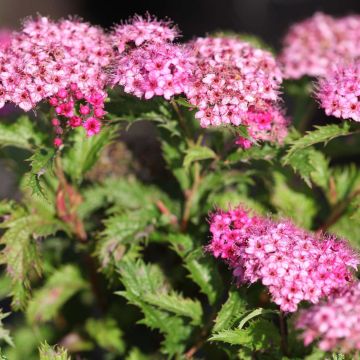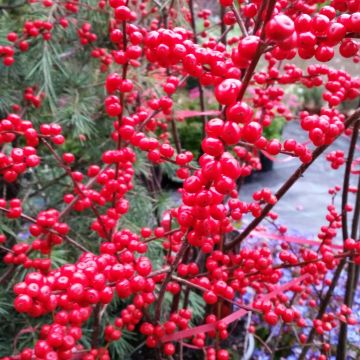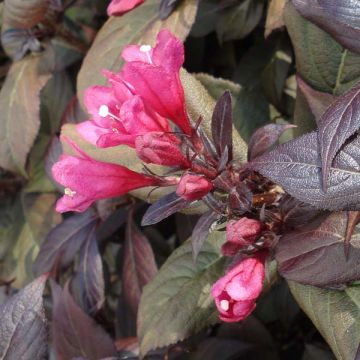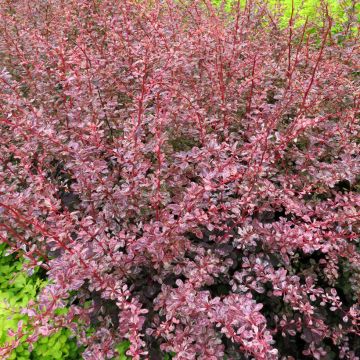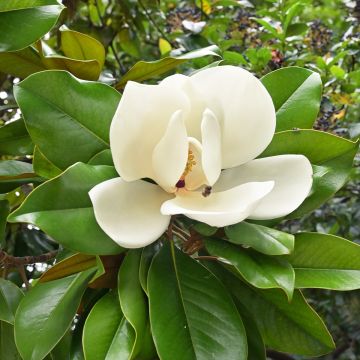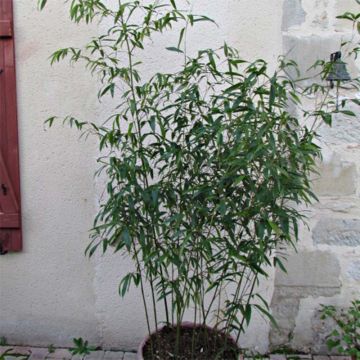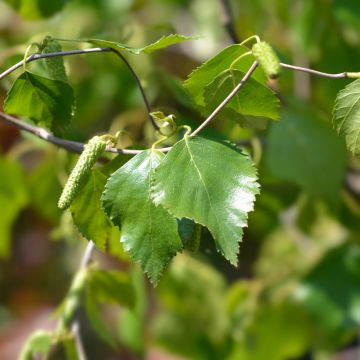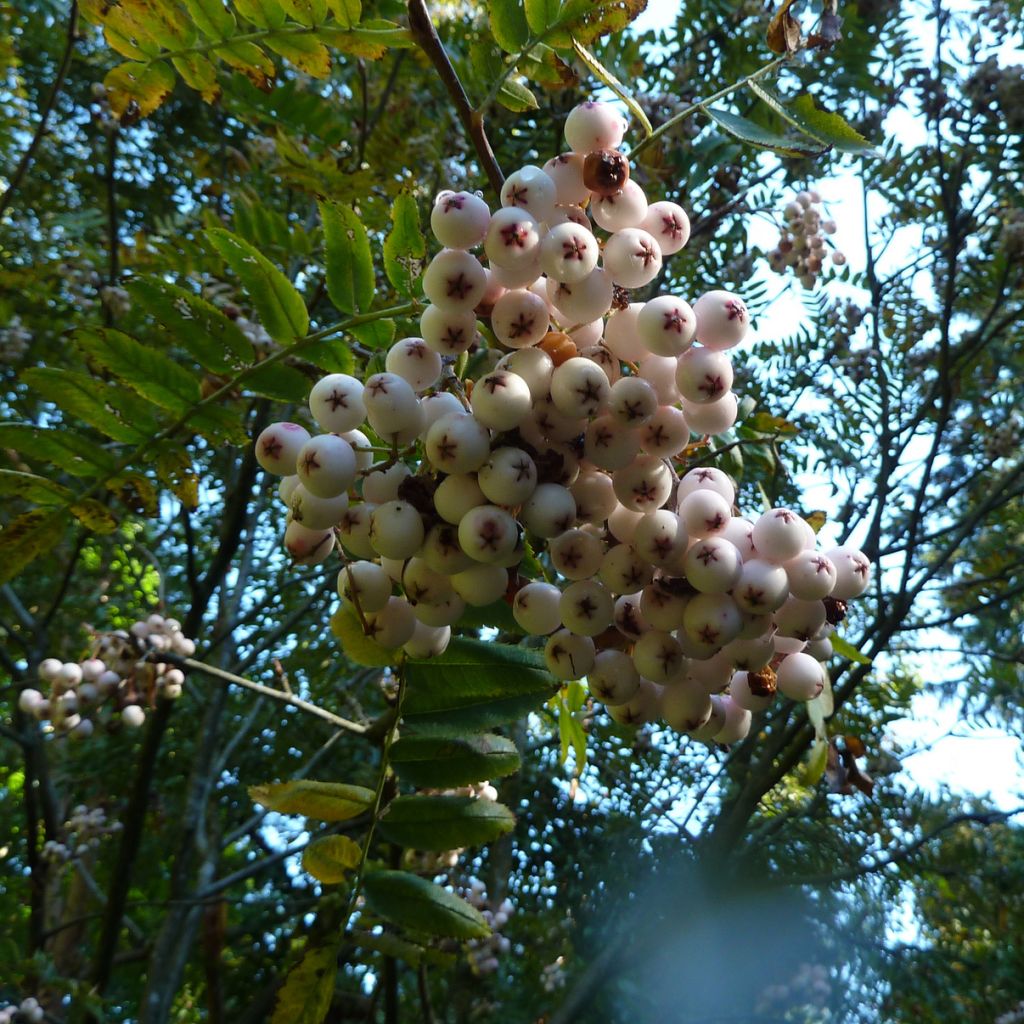

Sorbier du Cachemire - Sorbus cashmiriana
Sorbus cashmiriana
Sorbus cashmiriana
Kashmir Rowan
Why not try an alternative variety in stock?
View all →This plant carries a 24 months recovery warranty
More information
We guarantee the quality of our plants for a full growing cycle, and will replace at our expense any plant that fails to recover under normal climatic and planting conditions.
From €5.90 for pickup delivery and €6.90 for home delivery
Express home delivery from €8.90.
Does this plant fit my garden?
Set up your Plantfit profile →
Description
The Sorbus cashmiriana, also known as the Kashmir Rowan or Kashmir Whitebeam, is a small bush with a light habit, awarded by the Royal Horticultural Society, whose ornamental white berries remain until winter. They are preceded in spring by a flowering with pink buds that open into small pale pink to white flowers. Its foliage turns a golden orange colour in autumn and falls early. This rowan is a tolerant and versatile bush.
Kashmir Rowan belongs to the Rosaceae family. It is native to the western Himalayas. It will rarely reach 10 m (33ft) in height and 8 m (26ft) in width, with an average growth rate. It has an open and upright habit and is still not widely used here. The flowering occurs in May through pink buds opening into small pale pink or white flowers arranged in pendulous corymbs. It is followed from August to November by sweet white berries measuring 1.5 cm in diameter, which are ignored by birds and remain until winter. The leaves, measuring 15 to 23 cm (6 to 9in) in length, are composed of 17 to 19 elliptical leaflets, bright green on the upper side and greyish-green on the lower side. They turn yellow-orange in autumn and fall as early as October. The bare branches of shiny brown bark beautifully showcase the creamy white berries in winter.
Plant Sorbus cashmiriana in any soil, from moist to moderately dry, acidic, neutral to slightly alkaline, but well-drained. It prefers full sun but tolerates partial shade. This small bush has no specific requirements, but it may be less cold-hardy than other rowans; avoid planting it in exposed areas to cold winds and frost pockets. Its roots need air: if planted in heavy and wet soil, they will remain shallow, increasing the risk of uprooting by strong winds. If necessary, perform maintenance pruning before the start of new growth, removing diseased or dead wood and crossing branches.
Kashmir Rowan is a bush for informal hedges, woodlands, or alignments. Its modest size allows it to be accommodated in small or large gardens. It can be incorporated into a country hedge, accompanied by tall bushes such as Hippophae rhamnoides, Cotoneaster 'Cornubia', Euonymus myrianthus, or Parrotia persica, and of course, the flamboyant cypresses in autumn.
Sorbus means "to drink" in Latin, alluding to the fruits of the typical species, which are very astringent and make one thirsty.
Report an error about the product description
Plant habit
Flowering
Foliage
Botanical data
Sorbus
cashmiriana
Rosaceae
Kashmir Rowan
Central Asia
Other Sorbus - Mountain Ash
Planting and care
Plant the Sorbus cashmiriana in any soil, from moist to moderately dry, acidic, neutral to slightly alkaline, but well-drained. It thrives in the sun but tolerates partial shade. This small tree has no specific requirements, but it may be less cold-resistant than other rowan trees; avoid planting it in exposed areas to cold winds and frost pockets. Its roots need air: if planted in heavy and wet soil, they will remain shallow, increasing the risk of uprooting by strong winds. If necessary, perform maintenance pruning before the start of the growing season, removing diseased or dead wood and crossing branches.
Planting period
Intended location
Care
This item has not been reviewed yet - be the first to leave a review about it.
Striking foliage shrubs
Haven't found what you were looking for?
Hardiness is the lowest winter temperature a plant can endure without suffering serious damage or even dying. However, hardiness is affected by location (a sheltered area, such as a patio), protection (winter cover) and soil type (hardiness is improved by well-drained soil).

Photo Sharing Terms & Conditions
In order to encourage gardeners to interact and share their experiences, Promesse de fleurs offers various media enabling content to be uploaded onto its Site - in particular via the ‘Photo sharing’ module.
The User agrees to refrain from:
- Posting any content that is illegal, prejudicial, insulting, racist, inciteful to hatred, revisionist, contrary to public decency, that infringes on privacy or on the privacy rights of third parties, in particular the publicity rights of persons and goods, intellectual property rights, or the right to privacy.
- Submitting content on behalf of a third party;
- Impersonate the identity of a third party and/or publish any personal information about a third party;
In general, the User undertakes to refrain from any unethical behaviour.
All Content (in particular text, comments, files, images, photos, videos, creative works, etc.), which may be subject to property or intellectual property rights, image or other private rights, shall remain the property of the User, subject to the limited rights granted by the terms of the licence granted by Promesse de fleurs as stated below. Users are at liberty to publish or not to publish such Content on the Site, notably via the ‘Photo Sharing’ facility, and accept that this Content shall be made public and freely accessible, notably on the Internet.
Users further acknowledge, undertake to have ,and guarantee that they hold all necessary rights and permissions to publish such material on the Site, in particular with regard to the legislation in force pertaining to any privacy, property, intellectual property, image, or contractual rights, or rights of any other nature. By publishing such Content on the Site, Users acknowledge accepting full liability as publishers of the Content within the meaning of the law, and grant Promesse de fleurs, free of charge, an inclusive, worldwide licence for the said Content for the entire duration of its publication, including all reproduction, representation, up/downloading, displaying, performing, transmission, and storage rights.
Users also grant permission for their name to be linked to the Content and accept that this link may not always be made available.
By engaging in posting material, Users consent to their Content becoming automatically accessible on the Internet, in particular on other sites and/or blogs and/or web pages of the Promesse de fleurs site, including in particular social pages and the Promesse de fleurs catalogue.
Users may secure the removal of entrusted content free of charge by issuing a simple request via our contact form.
The flowering period indicated on our website applies to countries and regions located in USDA zone 8 (France, the United Kingdom, Ireland, the Netherlands, etc.)
It will vary according to where you live:
- In zones 9 to 10 (Italy, Spain, Greece, etc.), flowering will occur about 2 to 4 weeks earlier.
- In zones 6 to 7 (Germany, Poland, Slovenia, and lower mountainous regions), flowering will be delayed by 2 to 3 weeks.
- In zone 5 (Central Europe, Scandinavia), blooming will be delayed by 3 to 5 weeks.
In temperate climates, pruning of spring-flowering shrubs (forsythia, spireas, etc.) should be done just after flowering.
Pruning of summer-flowering shrubs (Indian Lilac, Perovskia, etc.) can be done in winter or spring.
In cold regions as well as with frost-sensitive plants, avoid pruning too early when severe frosts may still occur.
The planting period indicated on our website applies to countries and regions located in USDA zone 8 (France, United Kingdom, Ireland, Netherlands).
It will vary according to where you live:
- In Mediterranean zones (Marseille, Madrid, Milan, etc.), autumn and winter are the best planting periods.
- In continental zones (Strasbourg, Munich, Vienna, etc.), delay planting by 2 to 3 weeks in spring and bring it forward by 2 to 4 weeks in autumn.
- In mountainous regions (the Alps, Pyrenees, Carpathians, etc.), it is best to plant in late spring (May-June) or late summer (August-September).
The harvesting period indicated on our website applies to countries and regions in USDA zone 8 (France, England, Ireland, the Netherlands).
In colder areas (Scandinavia, Poland, Austria...) fruit and vegetable harvests are likely to be delayed by 3-4 weeks.
In warmer areas (Italy, Spain, Greece, etc.), harvesting will probably take place earlier, depending on weather conditions.
The sowing periods indicated on our website apply to countries and regions within USDA Zone 8 (France, UK, Ireland, Netherlands).
In colder areas (Scandinavia, Poland, Austria...), delay any outdoor sowing by 3-4 weeks, or sow under glass.
In warmer climes (Italy, Spain, Greece, etc.), bring outdoor sowing forward by a few weeks.



































